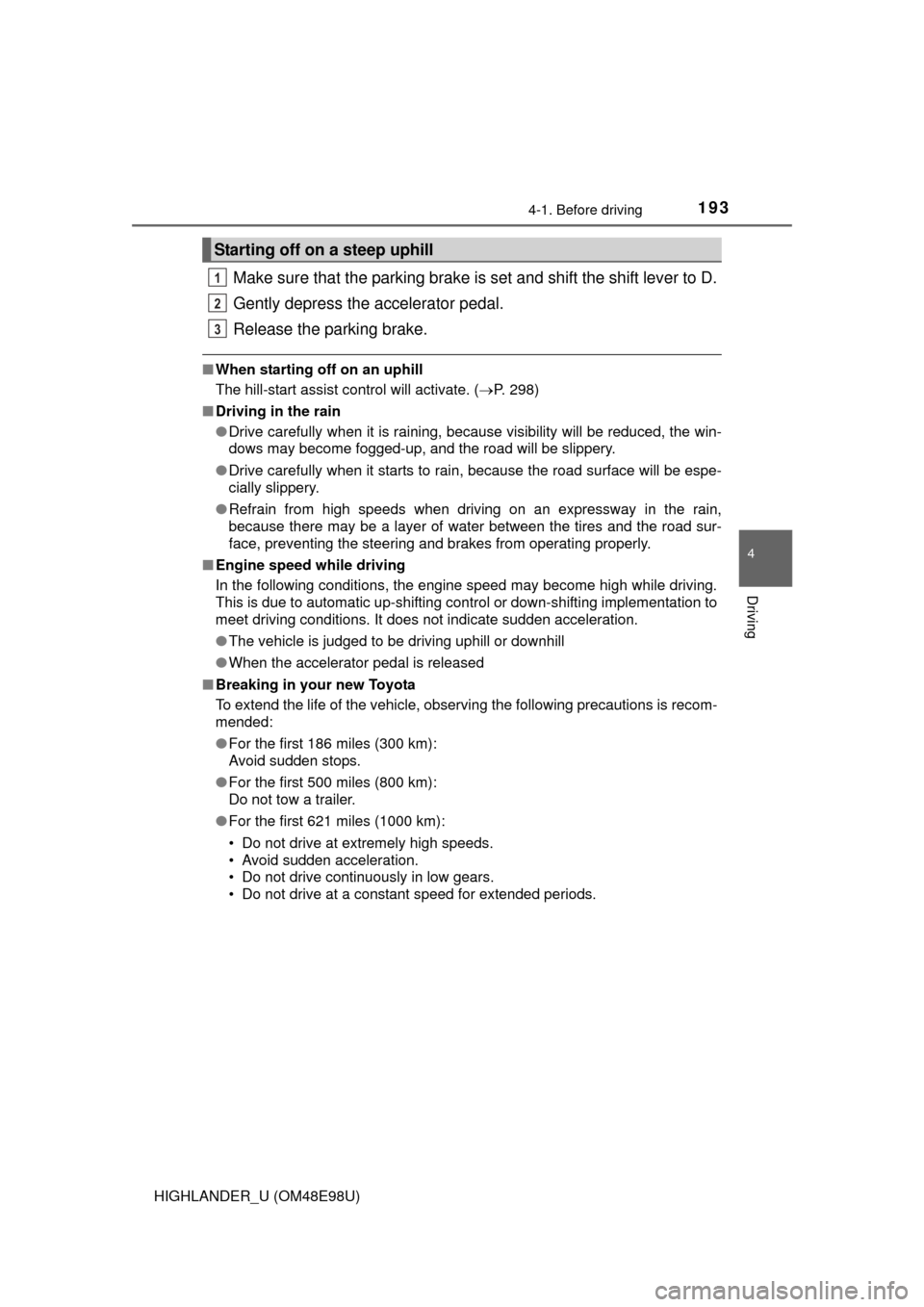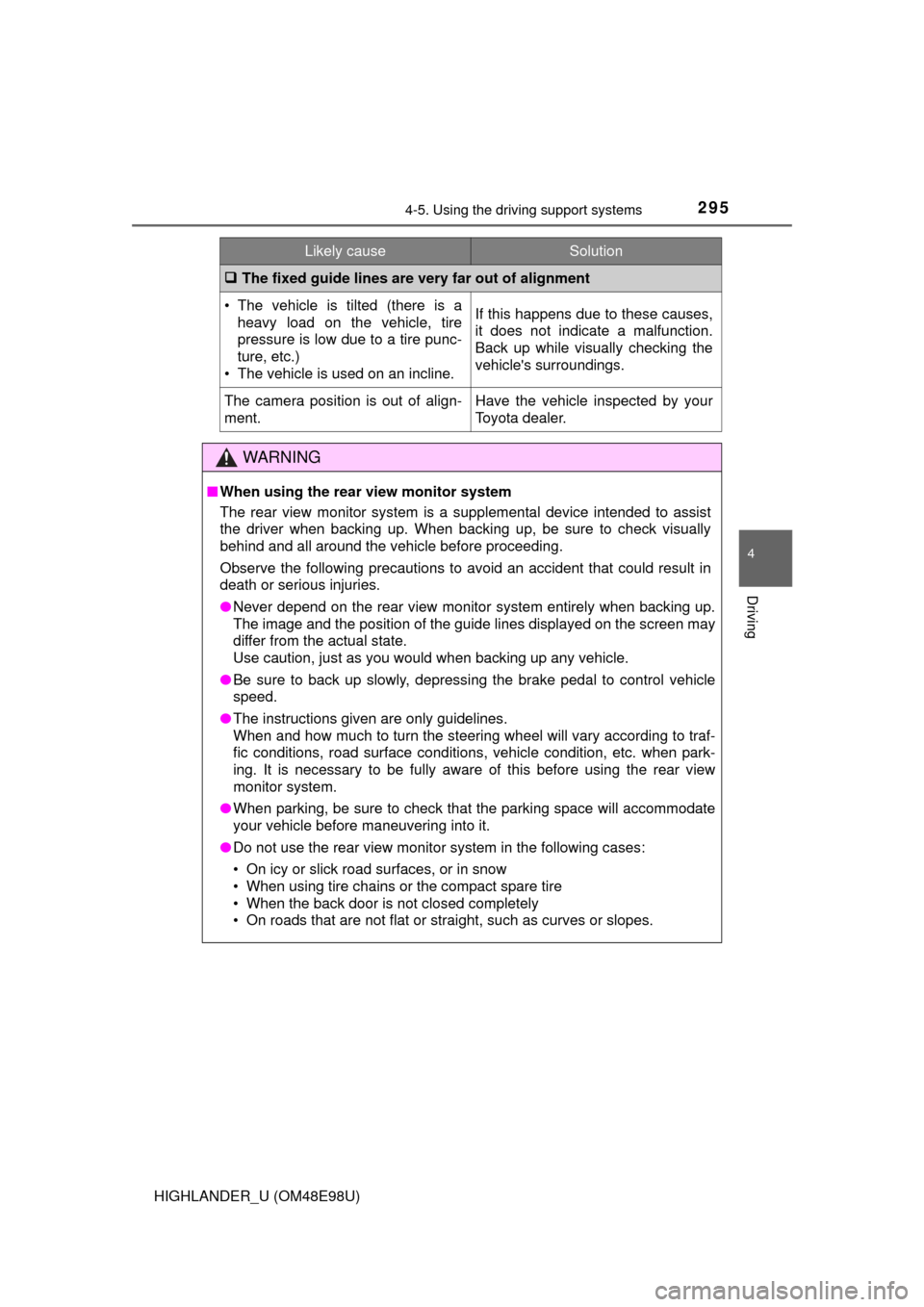2015 TOYOTA HIGHLANDER park assist
[x] Cancel search: park assistPage 3 of 712

3
1
8 7
6
5
4
3
2
9
HIGHLANDER_U (OM48E98U)
10
3-4. Adjusting the steering wheel and mirrors
Steering wheel .................. 172
Inside rear view mirror....... 174
Outside rear view mirrors ............................. 176
3-5. Opening and closing the windows
Power windows ................. 178
Moon roof .......................... 182
Panoramic moon roof ........ 186
4-1. Before driving Driving the vehicle ............. 192
Cargo and luggage............ 201
Vehicle load limits ............. 206
Trailer towing..................... 207
Dinghy towing.................... 224
4-2. Driving procedures Engine (ignition) switch (vehicles without a
smart key system) ........... 225
Engine (ignition) switch (vehicles with a smart
key system) ..................... 228
Automatic transmission ..... 234
Turn signal lever................ 239
Parking brake .................... 240 4-3. Operating the lights and
wipers
Headlight switch ................ 241
Automatic High Beam ........ 246
Fog light switch .................. 252
Windshield wipers and washer ............................. 253
Rear window wiper and washer ............................. 255
4-4. Refueling Opening the fuel tank cap................................... 257
4-5. Using the driving support systems
Cruise control .................... 261
Dynamic radar cruise control.............................. 266
LDA (Lane Departure Alert)..... 280
Rear view monitor system ............................. 288
All-wheel drive lock switch .............................. 297
Driving assist systems ....... 298
Downhill assist control system ............................. 304
PCS (Pre-Collision System)..... 306
BSM (Blind Spot Monitor)......... 313
• The Blind Spot Monitor function......................... 317
• The Rear Cross Traffic Alert function ................ 320
4-6. Driving tips Winter driving tips .............. 323
Utility vehicle precautions ...................... 327
4Driving
Page 18 of 712

18Pictorial index
HIGHLANDER_U (OM48E98U)
■Switches
Automatic High Beam switch*1 . . . . . . . . . . . . . . . . . . . . . . P. 246
BSM (Blind Spot Monitor) main switch
*1 . . . . . . . . . . . . . . P. 313
LDA (Lane Departure Alert) switch
*1. . . . . . . . . . . . . . . . . . P. 280
Power back door switch
*1 . . . . . . . . . . . . . . . . . . . . . . . . . . P. 129
Windshield wiper de-icer switch
*1. . . . . . . . . . . . . . . . P. 424, 431
Heated steering wheel switch
*1. . . . . . . . . . . . . . . . . . . . . . P. 442
Intuitive parking assist switch
*1, 2
1
2
3
4
5
6
7
Page 91 of 712

912. Instrument cluster
2
Instrument cluster
HIGHLANDER_U (OM48E98U)
The indicators inform the driver of the operating state of the vehicle’s
various systems.
Indicators
Turn signal indicator
( P. 239)*1, 4 Slip indicator ( P. 300)
(U.S.A.)
Headlight indicator
(P. 241)*1VSC OFF indicator
(P. 300)
(Canada)
Tail light indicator
(P. 241) *1, 2, 5Pre-collision system
warning light ( P. 306)
Headlight high beam
indicator ( P. 242)
*1, 2All-wheel drive lock indi-
cator (P. 297)
*2Automatic High Beam
indicator ( P. 246)*2Downhill assist control
system indicator
(P. 304)
*2Front fog light indicator
(P. 252)*2, 6, 7BSM (Blind Spot Moni-
tor) outside rear view
mirror indicators
(P. 313)
*2Cruise control indicator
(P. 261)*8Security indicator
(P. 80, 82)
*2Cruise control “SET”
indicator ( P. 261)*1, 9Eco Driving Indicator
Light (P. 107)
*2LDA (Lane Departure
Alert) indicator
(P. 280) Snow mode indicator
(
P. 235)
*2, 3 Intuitive parking assist
indicator*1, 8“AIR BAG ON/
OFF” indicator
(P. 53)
Page 191 of 712

191
4Driving
HIGHLANDER_U (OM48E98U)4-1. Before driving
Driving the vehicle ............. 192
Cargo and luggage ........... 201
Vehicle load limits ............. 206
Trailer towing..................... 207
Dinghy towing ................... 224
4-2. Driving procedures Engine (ignition) switch (vehicles without a
smart key system) ........... 225
Engine (ignition) switch (vehicles with a smart
key system) ..................... 228
Automatic transmission ..... 234
Turn signal lever................ 239
Parking brake .................... 240
4-3. Operating the lights and wipers
Headlight switch ................ 241
Automatic High Beam ....... 246
Fog light switch ................. 252
Windshield wipers and washer ............................ 253
Rear window wiper and washer ............................ 255
4-4. Refueling Opening the fuel tank cap .................................. 257 4-5. Using the driving support
systems
Cruise control .................... 261
Dynamic radar cruise control ............................. 266
LDA (Lane Departure Alert) .... 280
Rear view monitor system ............................ 288
All-wheel drive lock switch .............................. 297
Driving assist systems ...... 298
Downhill assist control system ............................ 304
PCS (Pre-Collision System) .... 306
BSM (Blind Spot Monitor) ........ 313
• The Blind Spot Monitor function ......................... 317
• The Rear Cross Traffic Alert function ................. 320
4-6. Driving tips Winter driving tips ............. 323
Utility vehicle precautions ..................... 327
Page 193 of 712

1934-1. Before driving
4
Driving
HIGHLANDER_U (OM48E98U)
Make sure that the parking brake is set and shift the shift lever to D.
Gently depress the accelerator pedal.
Release the parking brake.
■When starting off on an uphill
The hill-start assist control will activate. ( P. 298)
■ Driving in the rain
●Drive carefully when it is raining, because visibility will be reduced, the win-
dows may become fogged-up, and the road will be slippery.
● Drive carefully when it starts to rain, because the road surface will be espe-
cially slippery.
● Refrain from high speeds when driving on an expressway in the rain,
because there may be a layer of water between the tires and the road sur-
face, preventing the steering and brakes from operating properly.
■ Engine speed while driving
In the following conditions, the engine speed may become high while driving.
This is due to automatic up-shifting control or down-shifting implementation to
meet driving conditions. It does not indicate sudden acceleration.
●The vehicle is judged to be driving uphill or downhill
● When the accelerator pedal is released
■ Breaking in your new Toyota
To extend the life of the vehicle, observing the following precautions is recom-
mended:
●For the first 186 miles (300 km):
Avoid sudden stops.
● For the first 500 miles (800 km):
Do not tow a trailer.
● For the first 621 miles (1000 km):
• Do not drive at extremely high speeds.
• Avoid sudden acceleration.
• Do not drive continuously in low gears.
• Do not drive at a constant speed for extended periods.
Starting off on a steep uphill
1
2
3
Page 194 of 712

1944-1. Before driving
HIGHLANDER_U (OM48E98U)■
Drum-in-disc type parking brake system
Your vehicle has a drum-in-disc type parking brake system. This type of brake
system needs bedding-down of the brake shoes periodically or whenever the
parking brake shoes and/or drum are replaced. Have your Toyota dealer per-
form the bedding down operation.
■ Operating your vehicle in a foreign country
Comply with the relevant vehicle registration laws and confirm the availability
of the correct fuel. ( P. 635)
WARNING
Observe the following precautions.
Failure to do so may result in death or serious injury.
■When starting the vehicle
Always keep your foot on the brake pedal while stopped with the engine
running. This prevents the vehicle from creeping.
■ When driving the vehicle
● Do not drive if you are unfamiliar with the location of the brake and ac\
cel-
erator pedals to avoid depressing the wrong pedal.
• Accidentally depressing the accelerator pedal instead of the brake
pedal will result in sudden acceleration that may lead to an accident.
• When backing up, you may twist your body around, leading to a diffi- culty in operating the pedals. Make sure to operate the pedals properly.
• Make sure to keep a correct driving posture even when moving the
vehicle only slightly. This allows you to depress the brake and accelera-
tor pedals properly.
• Depress the brake pedal using your right foot. Depressing the brake
pedal using your left foot may delay response in an emergency, result-
ing in an accident.
● Do not drive the vehicle over or stop the vehicle near flammable materials.
The exhaust system and exhaust gases can be extremely hot. These hot
parts may cause a fire if there is any flammable material nearby.
● During normal driving, do not turn off the engine. Turning the engine off
while driving will not cause loss of steering or braking control, but the
power assist to these systems will be lost. This will make it more difficult to
steer and brake, so you should pull over and stop the vehicle as soon as it
is safe to do so.
However, in the event of an emergency, such as if it becomes impossible
to stop the vehicle in the normal way: P. 555
Page 199 of 712

1994-1. Before driving
4
Driving
HIGHLANDER_U (OM48E98U)
WARNING
Observe the following precautions.
Failure to do so may result in death or serious injury.
■When braking
● When the brakes are wet, drive more cautiously.
Braking distance increases when the brakes are wet, and this may cause
one side of the vehicle to brake differently than the other side. Also, the
parking brake may not securely hold the vehicle.
● If the power brake assist function does not operate, do not follow other\
vehicles closely and avoid hills or sharp turns that require braking.
In this case, braking is still possible, but the brake pedal should be
depressed more firmly than usual. Also, the braking distance will increase.
Have your brakes fixed immediately.
● Do not pump the brake pedal if the engine stalls.
Each push on the brake pedal uses up the reserve for the power-assisted
brakes.
● The brake system consists of 2 individual hydraulic systems; if one of the
systems fails, the other will still operate. In this case, the brake pedal
should be depressed more firmly than usual and the braking distance will
increase.
Have your brakes fixed immediately.
■ If the vehicle becomes stuck (AWD models)
Do not spin the wheels excessively when any of the tires is up in the air, or
the vehicle is stuck in sand, mud, etc. This may damage the driveline com-
ponents or propel the vehicle forward or backward, causing an accident.
NOTICE
■When driving the vehicle
● Do not depress the accelerator and brake pedals at the same time during
driving, as this may restrain driving torque.
● Do not use the accelerator pedal or depress the accelerator and brake
pedals at the same time to hold the vehicle on a hill.
Page 295 of 712

2954-5. Using the driving support systems
4
Driving
HIGHLANDER_U (OM48E98U)
The fixed guide lines are very far out of alignment
• The vehicle is tilted (there is a
heavy load on the vehicle, tire
pressure is low due to a tire punc-
ture, etc.)
• The vehicle is used on an incline.If this happens due to these causes,
it does not indicate a malfunction.
Back up while visually checking the
vehicle's surroundings.
The camera position is out of align-
ment.Have the vehicle inspected by your
Toyota dealer.
WARNING
■ When using the rear view monitor system
The rear view monitor system is a supplemental device intended to assist
the driver when backing up. When backing up, be sure to check visually
behind and all around the vehicle before proceeding.
Observe the following precautions to avoid an accident that could result in
death or serious injuries.
● Never depend on the rear view monitor system entirely when backing up.
The image and the position of the guide lines displayed on the screen may
differ from the actual state.
Use caution, just as you would when backing up any vehicle.
● Be sure to back up slowly, depressing the brake pedal to control vehicle
speed.
● The instructions given are only guidelines.
When and how much to turn the steering wheel will vary according to traf-
fic conditions, road surface conditions, vehicle condition, etc. when park-
ing. It is necessary to be fully aware of this before using the rear view
monitor system.
● When parking, be sure to check that the parking space will accommodate
your vehicle before maneuvering into it.
● Do not use the rear view monitor system in the following cases:
• On icy or slick road surfaces, or in snow
• When using tire chains or the compact spare tire
• When the back door is not closed completely
• On roads that are not flat or straight, such as curves or slopes.
Likely causeSolution